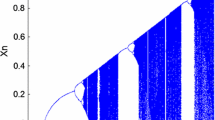Abstract
A new algorithm is presented in this paper by combining the true random sequences and the Tree Parity Machine (TPM), which is proven experimentally. Different from common method, true random sequences are proposed as dynamic inputs of TPM in this work compared to the pseudo-random sequences in the latest report. Therefore, several weaknesses of pseudo-random sequences can be overcome including finite precision effect, short cycle effect, and the dynamical property degradation. True random sequences are generated by artificial circuits, then, going through TPM neural networks. A series of key stream can be generated by the operation of XOR (exclusive OR) in the output of the TPMs. Randomness test shows that the final key stream can pass 15 tests proscribed by the National Institute of Standards and Technology (NIST). It was used in image encryption in the end, which demonstrates the improved randomness and gives a very promising prospect in secret communications.









Similar content being viewed by others
References
Ai XX, Sun KH, He SB (2014) Compound attractors between different chaotic systems. Acta Phys Sin 63(4):040503–8
Amaki T, Hashimoto M, Onoye T (2014) A process and temperature tolerant oscillator -based true random number generator. Ieice Trans Fund Elect Commun Comput Sci E97A(12):2393–2399
Azoug SE, Bouguezel S (2016) A non-linear preprocessing for opto-digital image encryption using multiple-parameter discrete fractional Fourier transform. Opt Commun 359:85–94
Bao BC, Liu Z (2008) A hyperchaotic attractor coined from chaotic Lu system. Chin Phys Lett 25(7):2396–2399
Boehl E (2014) Simple true random number generator for any semi-conductor technology. IET Comput Digit Tech 8(6):239–245
Chen SS (2011) The Post-Processing of Physical True Random Number Generation Based on Chaotic Laser. MS Thesis (Taiyuan: Taiyuan University of Technology.)
Chen TM, Jiang RR (2013) New hybrid stream cipher based on chaos and neural networks. Acta Phys Sin 62(4):040301–7
Chen XJ, Li Z, Cai JP, Bai BM (2011) New complexity metric of chaotic pseudorandom sequences using fuzzy relationship entropy. Acta Phys Sin 60(6):064215–10
Kinzel W, Kanter I (2002) Interacting neural networks and cryptography. Adv Solid State Phys 42:383–391
Kocarev L, Jakimoski G, Stojanovski T (1998) From chaotic maps to encryption schemes. IEEE Circuits Syst 98 (Monterey:IEEE) 4:514–517
Li X, Zhang GJ, Zhang XY (2015) Image encryption algorithm with compound chaotic maps. J Ambient Intell Humaniz Comput 6(5):563–570
Liu YJ, Yang QG, Pang GP (2010) A hyperchaotic system from the rabinovich system. J Comput Appl Math 234(1):101–113
Luo LG, Tee TJ, Chu PL (1998) Chaotic behavior in erbium-doped fiber-ring lasers. J Opt Soc Am B 15(3):972–978
Moqadasi H, Ghaznavi-Ghoushchi M (2015) B.A new Chua’s circuit with monolithic Chua’s diode and its use for efficient true random number generation in CMOS 180nm. Analog Integr Circ Sig Process 82:719–731
NIST Special Publication 800–22 (2011) http://csrc nistgovgroupsSTtoolkitrngdocumentation_software. Html
Tuncer T, Avaroglu E, Turk M (2014) Implementation of Non-periodic sampling true random number generator on FPGA. Inf Midem-J Microelectron Electron Comp Mat 44(4):296–302
Wang GY, He HL (2008) A new rosslor hyperchaotic system and its realization with systematic circuit parameter design. Chinese Physics B 17(11):4014–4021
Wang XY, Wang MJ (2008) A hyperchaos generated from Lorenz system. Physical A 387:3751–3758
Wu XJ, Kan HB, Kurths J (2015) A new color image encryption scheme based on DNA sequences and multiple improved 1D chaotic maps. Appl Soft Comput 37:24–39
Wu JJ, Xie ZW, Liu ZJ et al (2016) Multiple -image encryption based on computational ghost imaging. Opt Commun 359:38–43
Yanchuk S, Kapitaniak T (2001) Symmetry-increasing bifurcation as a predictor of a chaos-hyperchaos transition in coupled systems. Phys Rev E 64:056235–5
Yin RM, Yuan J, Shan XM (2011) Weak key analysis for chaotic cipher based on randomness properties. Sci China Informat Sci 41(7):777–788
Zhang HY, Wang RH (2012) Image encryption technology based on composite chaotic system and symmetric encryption algorithm. Key Eng Mater 500:465–470
Zhang W, Yu H, Zhao YL et al (2016) Image encryption based on three-dimensional bit matrix permutation. Signal Process 118:36–50
Zhou GM, Zhang DX, Liu YJ et al (2015) A novel image encryption algorithm based on chaos and Line map. Neurocomputing 169:150–157
Author information
Authors and Affiliations
Corresponding author
Rights and permissions
About this article
Cite this article
Pu, X., Tian, Xj., Zhang, J. et al. Chaotic multimedia stream cipher scheme based on true random sequence combined with tree parity machine. Multimed Tools Appl 76, 19881–19895 (2017). https://doi.org/10.1007/s11042-016-3728-0
Received:
Revised:
Accepted:
Published:
Issue Date:
DOI: https://doi.org/10.1007/s11042-016-3728-0




